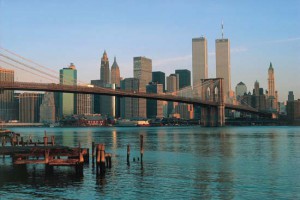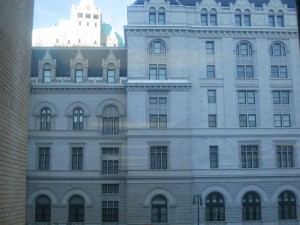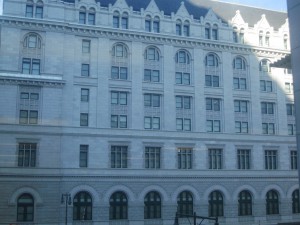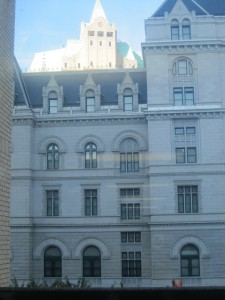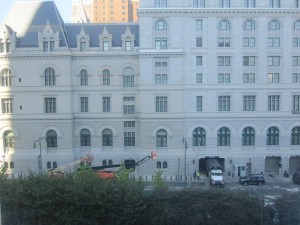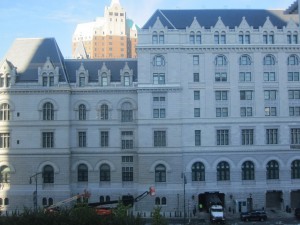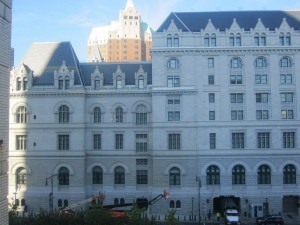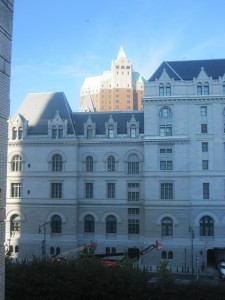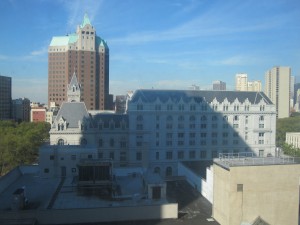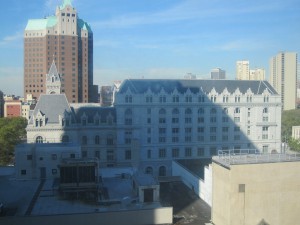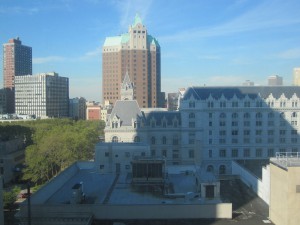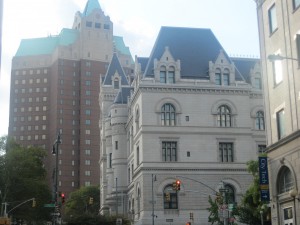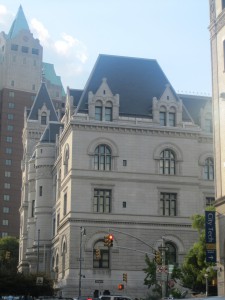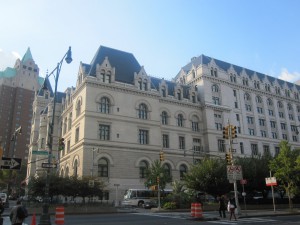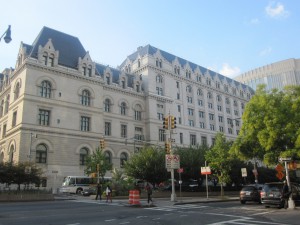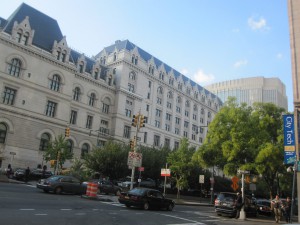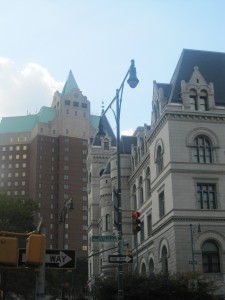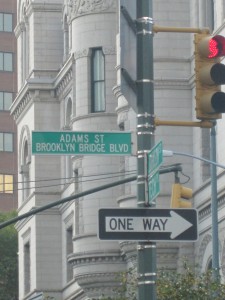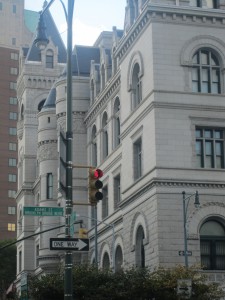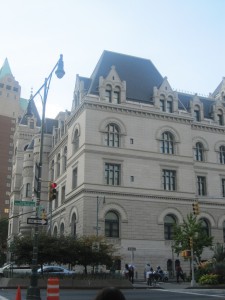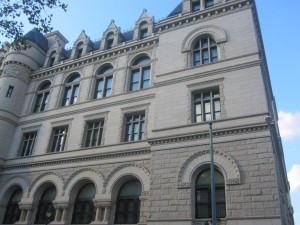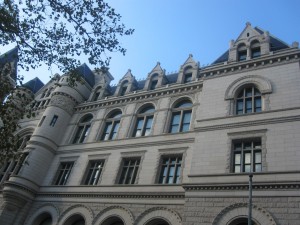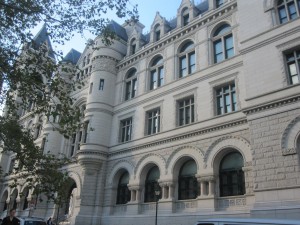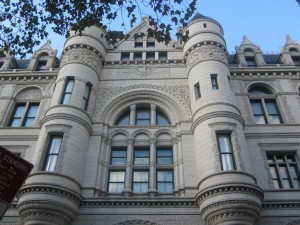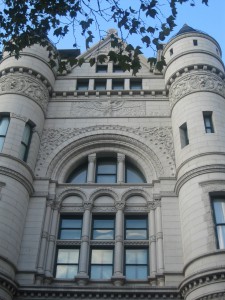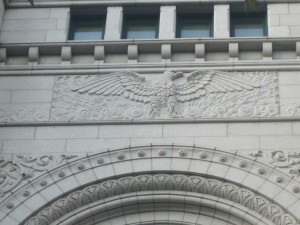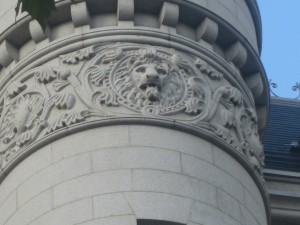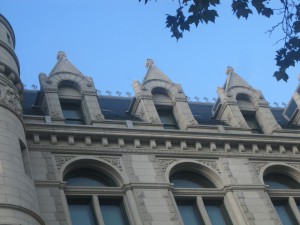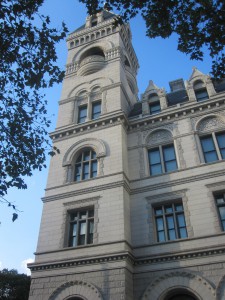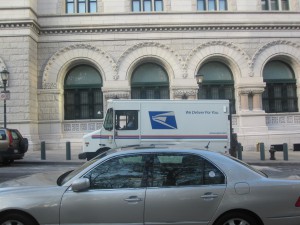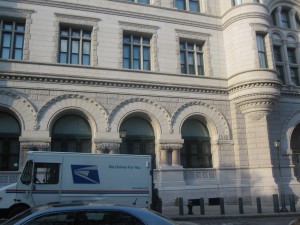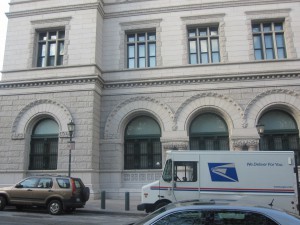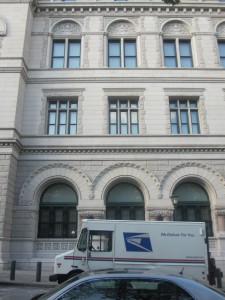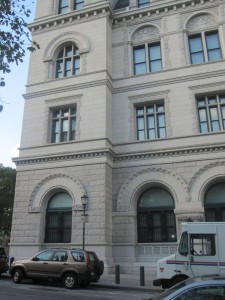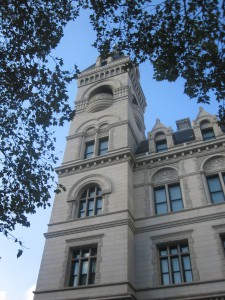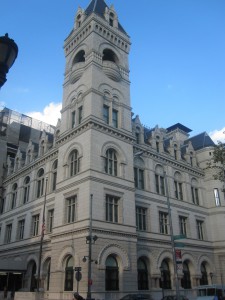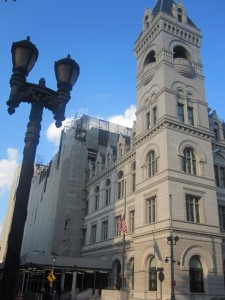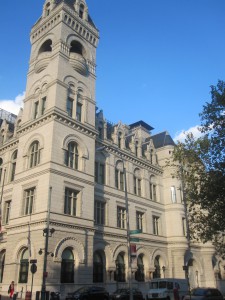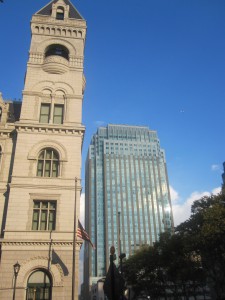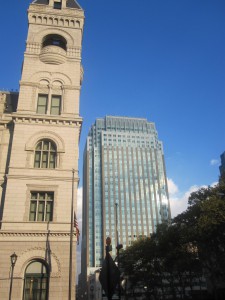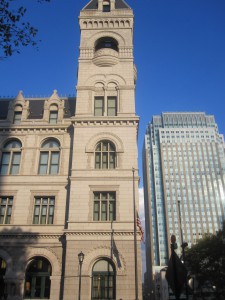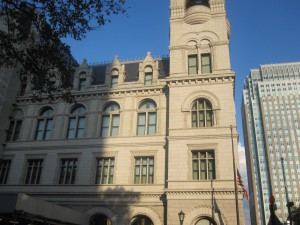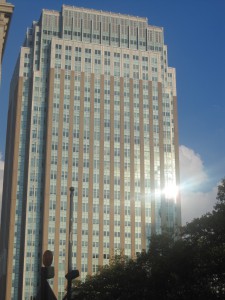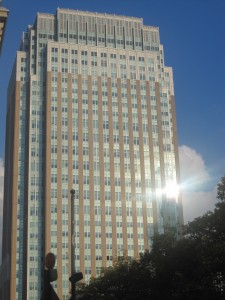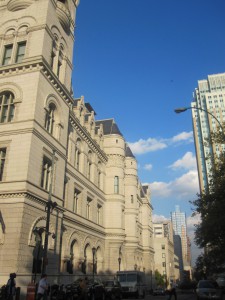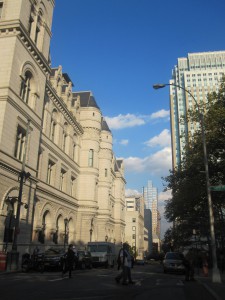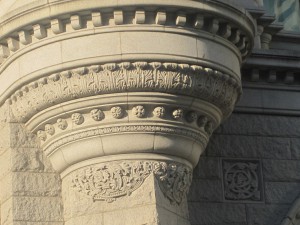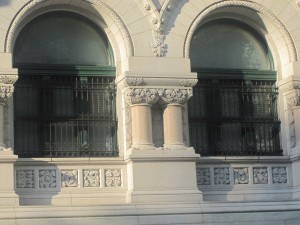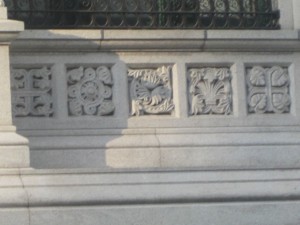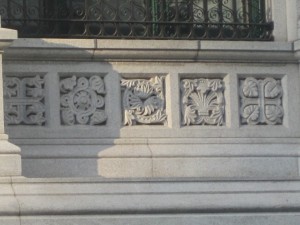On October 15, my class went to the Brooklyn Historical Society with Professor Rosen and Professor Davis. When we get there the librarian assisted us to the library and we went into our groups. Each group had to analyze three different typed of map based on the location around our school. We only got to work on two maps because we ran out of time. The first map we analyze was a manuscript from the 1800’s. It was very interesting to see how the person drew the map and the land had no buildings but people had lots. The street names were different only a couple street names still exist today. We got to learn about another person’s view point of Brooklyn. The second map we looked at was a flat map. It was very interesting to look at because it had a lot of information such as Retail stores, Theaters, Business and Finance, Automobile parking. The person/company illustrated the drawing with a lot of colors that made it stand out. Also used a lot of keys and included a legend. The two maps my group looked at was very informative and can be used to do further research projects. You really have to focus on these maps to get all the details you want from it. This experience to the BHS will definitely have an impact in the Learning community this semester because I will absolutely go back there for research I will need. There are a lot of books in the library that has useful information that can be used.
Tag Archives: Group C
Maps at Brooklyn Historical Society- “The Heart Of Brooklyn”
1-What is the map’s call number?
BA-[194-3].F1
2-What is the map’s title (if available)?
The Heart Of Brooklyn
3-Which collection does the map belong to?
Flat Maps
4-When was it made?
In the 1940’s
Physical description of the map:
5-What size is the map (approximately)?
14 inches by 22 inches
6-What colors does it use?
Gray, Pink, Green, Orange, Red, Blue, White, Yellow, Purple
7-What materials were used to make the map?
Paper
8-Who made the map?
It was printed by Hagstrom Company,Inc.,N.Y.C.Map Makers,Map Publishers. It was made by the Brooklyn Trust Company
Map content:
9-What location does the map depict?
Brooklyn Heights
10-What details does it include?
Retail stores, Theaters, Business and Finance, Automobile parking
11-What time period does the map depict? Is this the same as the time when it was made?
It depicts the 1940’s and it seems it was made around the same time
12-What is familiar to you about the location depicted in the map?
All the streets and designed areas seem similar to current
Interpretation and Reflection:
13-What is the purpose of the map?
To attract people to the area of Brooklyn for tourism
14-Why did it survive prior to becoming part of the archives at BHS?
It is very informative and was probably useful from when it was made until today
15-Why did BHS incorporate it into its collections?
It has to do with Brooklyn
16-What is familiar or unfamiliar about the map?
Everything is familiar street-wise. The style of cars and clothes is from an older time
17-What additional information would you want to better understand the map?
A scale
18-Where is City Tech in relation to this map?
The intersection of Johnson and Pearl street
Library Session on 10-2
On October 2,2013 my class and I went to the Ursula Schwerin Library with our English and Effective speaking professors. We were guided by a librarian that showed us around the library and the different sections in the library. Then we went up to the a room with computers where we used the computers to complete our assignments that were given to us by our professors. First Professor Davis gave us two sources and we had to find out if they were credible or not. They gave us time to work in our groups to figure out which one was more credible. I think that activity helped us a lot to read a source and to know what to look for so we can know if it is credible or not. After that we were given a topic which was the Brooklyn movie theater fire that happened in 1876. We had to use the library data page to look for books that were on that topic but that didn’t go so well because we couldn’t find any books on the fire. But I still think that the data page is very useful to find information if you had to write a paper. We then went on the internet to find credible sources that we can use if we had to write a paper on the fire. Last we used the library data base to look for articles on the fire and that was very useful because a lot of information came up. The library visit helped me a lot because I now know I can use the database and it will hep me find credible sources,
BHS Field Trip on 9-30
On September 30,2013 my class took a field trip to the Brooklyn Historical Society. We went with our English and Effective speaking professors and we stopped at various locations before we got there. First we stopped off at the Post office on Johnson street. I learned a lot of information about the history behind the post office. In 1876 there was a movie theater there that burned down and the tragedy was Brooklyn’s worst one as yet. Also I learned that the post office is the biggest one in Brooklyn. Second we went across the street to Columbus Circle which is a famous park in Brooklyn because back in the 1800’s that’s where Henry Ward Beecher who was an abolitionist and a famous speaker. People would travel there to hear him speak. Then on the other side of the park is a statue of Christopher Columbus and his statue is facing Borough Hall. After that we went to a famous church in Brooklyn and then headed Brooklyn Bridge park. At the park you can see the entire Manhattan and I really enjoyed the view because it looked so beautiful. I was so amazed because I never saw a more better view of the city from such a close distance. Finally we went to the Brooklyn Historical Society where I learned some more new facts. The first thing I learned was that the faces of the Philosophers,writers,actors,etc that were outside are called “busts”. Then we went inside to the library which was very big and antique looking. Last we went into the basement in a room and learned about the rules and necessitates.
TUG OF WAR WHO KNOWS BROOKLYN? BY BEN MCGRATH
TUG OF WAR, WHO KNOWS BROOKLYN? BY BEN MCGRATH is a very comical argument of whom is a better historian, John Manbeck or Brian Merlis. Neither are not trained in the field nor are seen as official historian by the government or people. However, this does not prevent them from acting as such or fighting about who is superior. Both man show little credentials other then living in the area of Brooklyn and having family ties to it. Both choose to write about objects in Brooklyn that they find interesting in their own opinions and I quote “I do neighborhoods that aren’t like, all gentrified, I could come out tomorrow with a ‘Park Slope, Then and Now’ book and make twenty thousand dollars. But no: I did East Flatbush. I’m doing Canarsie.”. History is a very delicate subject, most would say that it is written in stone and therefore is not delicate. However, the flaw in this is erosion, that stone will at one time become sand and anything that was craved on it will do so too. The Great library of Alexandria held the greatest amount of knowledge in the ancient world and in the fire much was lost – important events, locations, technology, documents, manuscripts, logs, maps – all that were taken for granted was gone in an instant. It took years to collate and copy all the work that were in there, some from the last remains of even older texts that were preserved. Only what survives is history that we know of, there will always be the history that was lost or seen as unnecessary. Then there is the history written by the victor, a bias history that shows only one side view of events.
So, here we have two people, who are driven to write about a subject that they have very personalized views on. Reader may mistake it for real history, however as previously stated, the writers show only what they want. Some readers, who has not read the newspaper article about them, will think about Brooklyn in a every different way than what it is or was.
It is the same as showing only the tops of buildings that are clean and unaffected by people vs showing the sidewalk and the bottom of the building that may be covered in graffiti and garbage. Two sides of the same coin, but one is light and the other is bleak.
Trip to the BHS
On Monday September 30, the class went on a tour featuring City Tech, The Federal building, post office, Columbus Park, Brooklyn Theater, and finally the Brooklyn Historical Society. Prof. Rosen and Prof. Davis explained each landmark as we passed by. Prof. Rosen explained one of the worst tragedies ever to happen in Brooklyn and that was the fire at the Brooklyn Theater which happened on December 5, 1876. About 300 individuals lost their lives due to the lack of exits and cramped stairwells. This quickly resulted into a reform on the architecture around safety hazards.
Prof. Rosen and Davis then led us to Columbus Park, there we saw the statue of Henry Ward Beecher, who was known for the his speeches on the abolition of slavery. The statue did not express its meaning clearly as it showed Henry Beecher standing at the top of the slaves while the slaves were praising him. We then traveled to the Brooklyn Heights Promenade where we saw the Brooklyn Bridge, Staten Island Ferry, and the Statue of Liberty. Our last stop which was the Brooklyn History Society which was a building that was built out of a red block called Terracotta, only a few buildings in Brooklyn were made of Terracotta. On the outside was a showing of 7 faces, Beethoven, Michelangelo, Gutenberg, Shakespeare, Columbus, Benjamin Franklin, and two faces implying the Indians and the Norse. Inside of the Brooklyn History Society was a library which seemed to me looked like a place for books with only few quantity. The library was had technical specs that would protect the books from light and had a rule that if you were taking a picture, flash was not allowed.
At the end of the day I can safely say that I enjoyed the tour Prof. Rosen and Davis took us on was very interesting because I never would have guessed such places were so close to my college campus at City Tech.
Location Choice
The Landmark I chose was the Brooklyn Bridge. It is a 10-15 min walk from City Tech. It is such a magnificent sight that it catches my eye instantly as I passed it every time I travel from Brooklyn to Manhattan and back. It was the longest bridge of it’s time when it was first opened on May 24, 1883. You can see the Staten Island Terminal, The Statue of Liberty, and the development of the new piers when you are on the bridge itself.
“You start building your own New York the time you lay your eyes on the city itself” was once said by the author of The Colossus of New York: “City Limits”. This quote means that you start to develop your own way of how you interpret the city of New York the moment you see something in the city that catches your eye, or the city itself. This quote relates to my reason of choosing the Brooklyn Bridge as the main idea of my project because not only does the bridge allow people to cross over to other boroughs of New York, it allows people to sight see almost everything between Manhattan and Brooklyn.
“The New York City you live in is not my New York City” is another quote also once said by Colson Whitehead which also relates to another reason that why I chose the Brooklyn Bridge for my project. It relates because I see the Brooklyn Bridge as a gateway to the other parts of New York, without it the city would not function how it does with it. As some people might not share that vision with me because they live elsewhere.
Brooklyn Historical Society
On Monday the class went on a walk from City Tech to the Federal building and post office which was across the street. It was at a time the Brooklyn Theater until it burned down in December 5, 1876. 287 to 300 people lost there lives that evening, following the phrase the show must go now. Other then ignoring an major threat to their welling being many on the 4th and 3rd tiers of the Theater were unable to get out due to the lack of exits and cramped stairwells. This led to a reform in the fire code of the city and remapping of potential fire starting building.
Then in Columbus we look at the statue of preacher Henry Ward Beecher, who was for the abolishment of slavery. However from his statue it would not be clear that he was so,due to his position above those who he was trying to free. A similar statue can be found at Plymouth Church several blocks away. From there we moved to the Brooklyn Heights Promenade that has an amazing view of Manhattan and the river. from there we could see Brooklyn and Manhattan bridges along with the new parks under construction below.
The last stop was the Brooklyn Historical Society which was made out of terracotta which is a red material somewhere between stone and brick. The outside had five faces, sculpted into it: and they are of Michelangelo, Beethoven, Gutenberg, Shakespeare, Columbus, and Benjamin Franklin. The entrance itself has a Norseman and Native American. And inside on the staircase there was sculpt of Pinky, who was a slave that Henry Ward Beecher helped set free. We then went to the library, which had a very high ceiling and also has a gallery which is used as an archive. As soon as I saw wooden pillars, the tall book shelves, the contemporary look like oil base lighting, I immediately thought of the library of Hogwarts in the Harry Potter series.
At the end of the day I thoroughly enjoyed the experience of walking in a part of Brooklyn that I never been in directly or passing by.
Trip to the Brooklyn Historical Society
Today our english class took a trip around the outskirts of downtown Brooklyn. This area was pretty familiar for me because I used to do deliveries all over downtown. Even though, I still enjoyed it from the perspective of a student learning more about each landmark I had passed and payed no mind to originally. Our first stop was the post office/ bankruptcy court. This building says a lot about what downtown Brooklyn is going through right now as far as restoration and construction. One thing I had not known before this trip is that this very building used to be a huge theater where one of Brooklyn’s worst tragedies occured. There was a fire that burned down the whole building and killed hundreds. This is very sad but also very significant. I’m glad I have the knowledge now. Brooklyn is also happy to have the knowledge because they changed their whole building code to try to avoid anymore of these terrible incidences. Our second stop was the statue of Henry Beecher in Columbus Square. Although I had a little bit of trouble hearing at this particular checkpoint, I gathered that he was an abolitionist of slavery and he was successful in freeing as many as he could by holding “mock auctions”. The next and third stop was a church with yet again, another statue of Henry. This time he seemed more in the spirit of preaching considering his posture and gestures. The court yard that he was front and center of was beautiful with green grass and an architecturally masterful building behind. The fact that there was a preschool just to the left is perhaps a juxtaposition of young and old. It also shows how they can benefit each other. Our last stop before the museum was the water front, which I had been to before, but never really had the clarity or necessity to take it all in. I saw everything I had seen before, just from a different view. As we walked from there to the museum, I noticed that we not only had walked for a bit of a distance, but we walked in one big circle. This would mean that the museum was just in our own backyard. I had passed the building many times as it is not far from my old job and maybe had looked up and said, “Wow those are some interesting heads.” I had never thought that there was a library and an entire historical society that had been around for well over a hundred years. Everything in that building, even though it may be recent, has some historical significance. Some of the books are so old that you need to keep them in certain light and humidity to keep them preserved, along with many other rules and regulations upon entry. These books and stories help us understand the past. Even though they may not be true; but only someones interpretation or ideas; they still come from a time that we don’t have a chance to visit other than records that can be proven to come from that time period. Having a tour guide definitely helps me understand things a lot better because you can ask any questions and they will more often than not have the answer. If they don’t, they can certainly point you in the right direction so that you can figure it out. I can take my experiences today and improve on my understanding of my Project #2 location by going back and considering what may have been there before that; what brought it to be located where it is; and other historical factors such as those. Certainly I could go to the society when it is open to do a little research and just become more well-rounded on the subject all together.
Location
The location i chose is the Federal building and post office that is a cross the street from the bookstore entrance of the city tech building. I noticed it not too long ago when I went to buy books for class and saw a style that was of a time passed. There are also two parts to the building, one is the original and the other is the expansion. The original has more detail on the face of it with arches, towers and engraving. The newer section is more focused on functionality and has less of the style found on the old. also being across from a technical based collage and a court building covered in glass and steel seemed to fit well the idea of old and new.This was the main juxtaposition that I saw there. the following 52 photos were taken at various locations, heights and times to show case the entire building and the surrounding area.
It is also the site of the Brooklyn Theater Fire on December 5, 1876 where 278 to 300 people died. There is sing or memorial at the location and few would even know about it. We can not see the past but it is there, where a court and post office now stand a play would go on into the night.

